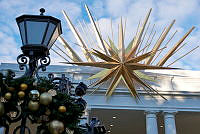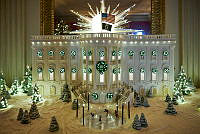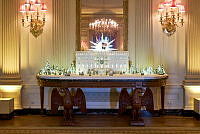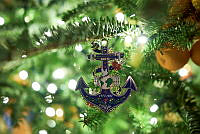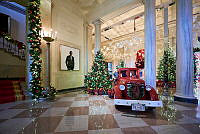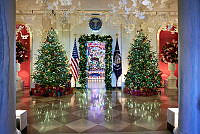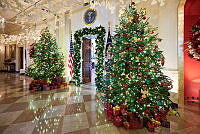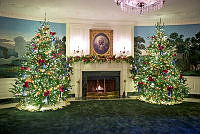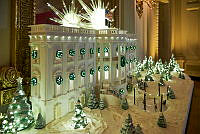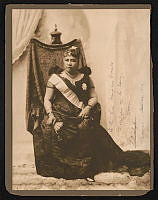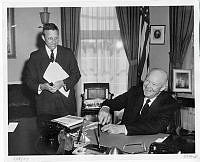Rubenstein Center Scholarship
Jimmy Carter, Iran, and the Canadian Caper
The Iran Hostage Crisis
The Iran Hostage Crisis was one of the most important issues of Jimmy Carter’s presidency and likely one of the reasons for his election loss in 1980. But at the beginning of Carter’s presidency, the United States and Iran were allies. Carter called Iran “an island of stability in one of the more troubled areas of the world” during a visit to Tehran and maintained a strategic relationship with the Shah of Iran Mohammed Reza Pahlavi.1

The Carters stand with the Shah of Iran Mohammed Reza Pahlavi and Empress Farah Pahlavi during the State Arrival, 1977.
Jimmy Carter Presidential Library & Museum/NARAIn November 1977, President Carter and First Lady Rosalynn Carter hosted the Shah and his wife, Empress Farah Pahlavi, at the White House for a State Visit. The Shah’s arrival sparked a massive protest between pro and anti-Shah factions on the Ellipse that injured more than one hundred demonstrators and police officers.2 Iranian protests against the Shah’s leadership increased in the months that followed, prompting a revolution which ousted him from power in early 1979 and reinstated Islamic fundamentalist Ayatollah Khomeini to power.3 Meanwhile, anti-American sentiment swelled in Iran, particularly after President Carter allowed the exiled Shah into the Unites States for medical treatment in October 1979. These tensions reached a breaking point less than two weeks later.

Anti-Shah protestors in Washington, D.C. just after the seizure of the U.S. embassy in Tehran
Library of CongressOn November 4, 1979, Iranian students seized the U.S. Embassy in Tehran and took sixty-six American diplomats and military personnel hostage, sending the U.S. into a full-scale diplomatic crisis that lasted for 444 days.4 But six State Department employees managed to evade capture during the attack, and their story marks a high point in both covert operations and international collaboration.5
The following Americans escaped the complex that day: Robert Anders (consular officer); Mark J. Lijek (consular officer); Cora A. Lijek (consular assistant); Henry L. Schatz, (agriculture attaché); Joseph D. Stafford (consular officer); and Kathleen F. Stafford (consular assistant).6 Ambassador Ken Taylor of Canada and John Sheardown, a Canadian diplomat, sheltered the hostages for approximately three months while American intelligence operatives raced to bring them home—but they would need to be creative.7 Due to the political climate and the ongoing hostage crisis, the diplomats could not simply leave Iran. Enter Central Intelligence Agency (CIA) officer Antonio “Tony” Mendez.
First, the six needed a cover story—but none of the diplomats were trained in the art of espionage. The CIA considered many covers for the group’s presence in Iran. Americans looking for work, nutritionists studying crops, oil workers… but in the end, Mendez had an epiphany. In his words, “While it was true that normally cover stories were designed to be mundane, we weren’t dealing with a normal situation here. What if we designed a cover story so fantastic that nobody would believe it was being used for operational purposes?”8 In the end, Mendez put together a risky plan, claiming the diplomats were a Hollywood film crew scouting locations for a new American science fiction film called Argo. Their cover was intensive—a fake production company called “Studio Six Productions” opened in Hollywood and business cards, movie ads, and a script all legitimized the project. It sounded outrageous—but in late January 1980, Mendez received a message: “PRESIDENT HAS JUST APPROVED THE FINDING. YOU MAY PROCEED ON YOUR MISSION TO TEHRAN. GOOD LUCK.”9

Disguise glasses worn by embassy employee Kathleen Stafford during the "Canadian Caper"
National Museum of American DiplomacyWhile CIA operatives worked to build a convincing cover for the diplomats, the U.S. and Canadian governments worked together in unprecedented ways. President Carter later recalled: “…I was very much involved with the Canadian government because the Canadian government would not legally permit six false passports to be issued. So the Canadian Parliament had to go into secret session the first time in history, and they voted to let us use six Canadian passports that were false.”10
With these forged documents in hand, Tony Mendez flew to Tehran with CIA linguist Ed Johnson to oversee the exfiltration of the six.11 Upon their arrival, they trained the diplomats on their cover stories and helped disguise them as Hollywood big shots.12 After a nerve-wracking experience at the airport, including an unexpected mechanical delay, the diplomats made it out of Iran on January 28, 1980.13 Jimmy Carter recalled in his memoir “When the news was finally released…Ambassador Kenneth Taylor and the other courageous Canadians became instant heroes. They well deserved the outpouring of gratitude from millions of Americans, who were especially thankful for this rare good news from Iran.”14 The cloak-and-dagger details and genius ruse behind the escape remained top secret, but Americans celebrated the small victory of their return.
In celebration, Carter hosted the diplomats in the Oval Office on February 1, 1980.15 The meeting was awkward at first for those who felt the president had mishandled the situation in Iran. But by the end, “Carter’s southern charm won them over.”16 They are pictured with the president below.

Carter meets with the Tehran Six in the Oval Office on February 1, 1980.
Jimmy Carter Presidential Library & Museum/NARAOn March 12, President Carter met with Tony Mendez in the Oval Office, listening to him recount the incredible story of Argo.17 Both Mendez and Johnson were awarded the Intelligence Star, one of the CIA’s highest honors, for their role in the exfiltration.18

Carter congratulates Tony Mendez in the Oval Office on March 12, 1980.
Central Intelligence AgencyUndeniably, the successful escape of the Tehran Six, now remembered as the “Canadian Caper,” marked a high point in the Iran Hostage Crisis, as good news came all too infrequently. Days turned into weeks, months into a year. Throughout negotiations, President Carter tried to avoid direct conflict with Iran, prioritizing the safe return of the hostages over decisive action.

Carter and advisors meet in the Cabinet Room during the Iran Hostage Crisis.
Jimmy Carter Presidential Library and Museum/NARAOne rescue attempt, Operation Eagle Claw, was aborted due to equipment failure; unfortunately, a helicopter crashed during departure, killing eight servicemembers.19 The president worked tirelessly through the final hours of his presidency to bring the hostages home; ultimately, Carter and his team negotiated the release of the fifty-two remaining hostages, but to Carter’s dismay, they were not released until after Ronald Reagan took the Oath of Office on January 20, 1981.20

Jimmy and Rosalynn Carter celebrate the release of the remaining hostages in the Oval Office on Inauguration Day.
Jimmy Carter LibraryThe next morning, Carter flew to West Germany to see the returning hostages on their way home.21 There, signs reading “Thank God and Jimmy they are home” and “We still love you, Mr. Carter,” greeted him. The teary-eyed former president embraced each of the hostages one by one.22 One week later, President Reagan celebrated the brave Americans at the White House with a massive South Lawn ceremony, parade, fireworks, and a reception.23

White House South Lawn ceremony for freed hostages
Ronald Reagan Presidential Library and Museum/NARAThe story of the Tehran Six did not go unheralded, either. President Reagan honored Canada’s assistance in their exfiltration, presenting the Congressional Gold Medal to Ambassador Taylor in the Rose Garden on June 16, 1981. The president remarked: “it's my great honor to present the medal to Kenneth Taylor whose valor, ingenuity, and steady nerves made possible this one happy chapter in the agony of those 444 days of hostage crisis.”24
In the end, the real tale of the Tehran Six and Argo remained classified until 1997, though most Americans remained unaware until the story hit the big screen in Argo, a film directed, produced, and starring Ben Affleck as Tony Mendez.
The Canadian Caper truly came full circle on February 24, 2013.25 That evening in the Diplomatic Reception Room, First Lady Michelle Obama announced that the Academy Award for Best Picture went to Argo.26 The movie’s fictional portrayal of the hostage exfiltration brought new attention to the story of the brave public servants and U.S. allies that made it out of Iran in secrecy.











